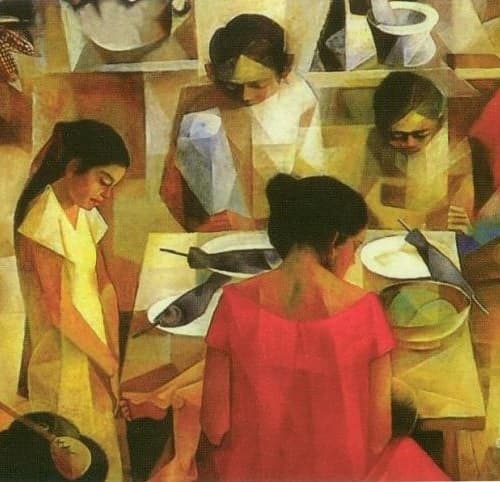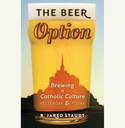Michael P. Foley,
Drinking with the Saints: The Sinner's Guide to a Holy Happy Hour
(Regnery History, 2015).
Chesterton aptly observed that the “Catholic Church is like a thick steak, a glass of red wine, and a good cigar.” He meant to convey the sacramentality of the Church, which both valorizes the good creation and makes it the bearer of a newness from “on high.” It is precisely in its liturgical calendar, with its feasts and fasts, that we can see this, or rather taste it; since it is through these that we experience the world with its rich fare taken up as it is into the history of salvation. It is to that feasting (not so much fasting) that Professor Michael P. Foley turns with his handsome and well-crafted book Drinking with the Saints: The Sinner’s Guide to a Holy Happy Hour.
Foley wrote the book because like Belloc, he has found that “[w]herever the Catholic sun doth shine, / There’s always laughter and good red wine.” Foley begins by regaling the reader with the “Catholic contribution to the spirits world” which “is almost as impressive as its contribution to the spirit world” (viii). For instance, Foley tells us that Chartreuse, “the world’s most magical liqueur, was perfected by Carthusian monks and is still made by them” (viii). Indeed, only two Carthusians “at any time know the recipe” (viii).
Behind the book is the intent to help “celebrate with friends and family one of the great jewels of Catholic life, the liturgical year” (x). As Foley observes, “Even a generic weekday on which a special feast day does not fall is called in Church Latin a feria, or ‘feast’” (x). So this book is about feasting, about the “refined and temperate art of drinking,” (x) and helping its readers to “be not sad but glad of heart” (xi).
Within its pages Foley provides “spiritual advice” for the entire liturgical year, its feasts and saints’ days. This includes: classic cocktails, historic beers, wines, and spirits crafted in centuries-old monasteries throughout the world; but it also includes not a few recipes of the author’s own crafting. And all of this is mixed with a good dose of history about the spirits themselves and the saints who made them (or for whom they are imbibed), together with advice about toasts and anything else that will add conviviality to a party.
The invitation to review this Drinking with the Saints was an invitation to follow Saint Thomas Aquinas and drink usque ad hilaritatem (to the point of hilarity). Thus, it was only appropriate that the first of the drinks I sampled in the arduous process of doing quality control on Professor Foley’s recipes was the “Fat Friar” (48). That drink is delicious mix of Benedictine, apple brandy, triple sec, and lemon juice. It warmed the cockles of my heart. Surprisingly, after sipping on the Fat Friar I found myself desiring to partake of more of Professor Foley’s recipes.
Among the other offerings sampled and in which I delighted was the “St. Lawrence No. 2” (210). While the drink takes its ingredients more from the Gulf of St. Lawrence than the man himself, it still was a fitting way to raise a glass to that gridiron saint. While I wasn’t quite roasted, I was certainly toasty after sampling the mix of bourbon, maple syrup, and lemon juice.
A few days later I invoked the Holy Ghost, by mixing up a “Green Ghost” (419) : a combination of gin, green Chartreuse, and lime juice. Its potency was enough to drive out any bad spirits that might have been prowling about seeking the ruin of souls. My guests did their part to banish bad spirits by imbibing “Vesper Martinis” (102) (a combination of gin, vodka, and white Lillet with a lemon peel garnish). With spirits this strong, no exorcism needed!
Guests—both here and in Heaven—are an important part of Drinking with the Saints. Indeed, Foley’s book wishes to remind us that when we feast here on Earth we are not alone; we feast with those already in Heaven, as a foretaste of the Heavenly Banquet. “Drinking with the faithful departed . . . affirms . . . that death, that silly stingless thing, has no dominion over the Mystical Body of Christ” (xi). Indeed, one’s “departed holy brother or sister in Christ is as alive” as one’s “pewmate” (xi). Thus, when we raise a glass to Thomas Aquinas, we are quite literally raising a glass with him. So pick up a copy of Drinking with the Saints, buy some top-shelf liquor, break out the shaker, and drink with the saints. Christ’s victory calls us to celebrate; and there is hardly a better way to do so than with Foley’s holy concoctions.
Conor B. Dugan is a husband, father of four, and attorney who lives in Grand Rapids, Michigan.
Conor B. Dugan is a husband, father of four, and attorney who lives in Grand Rapids, Michigan.



